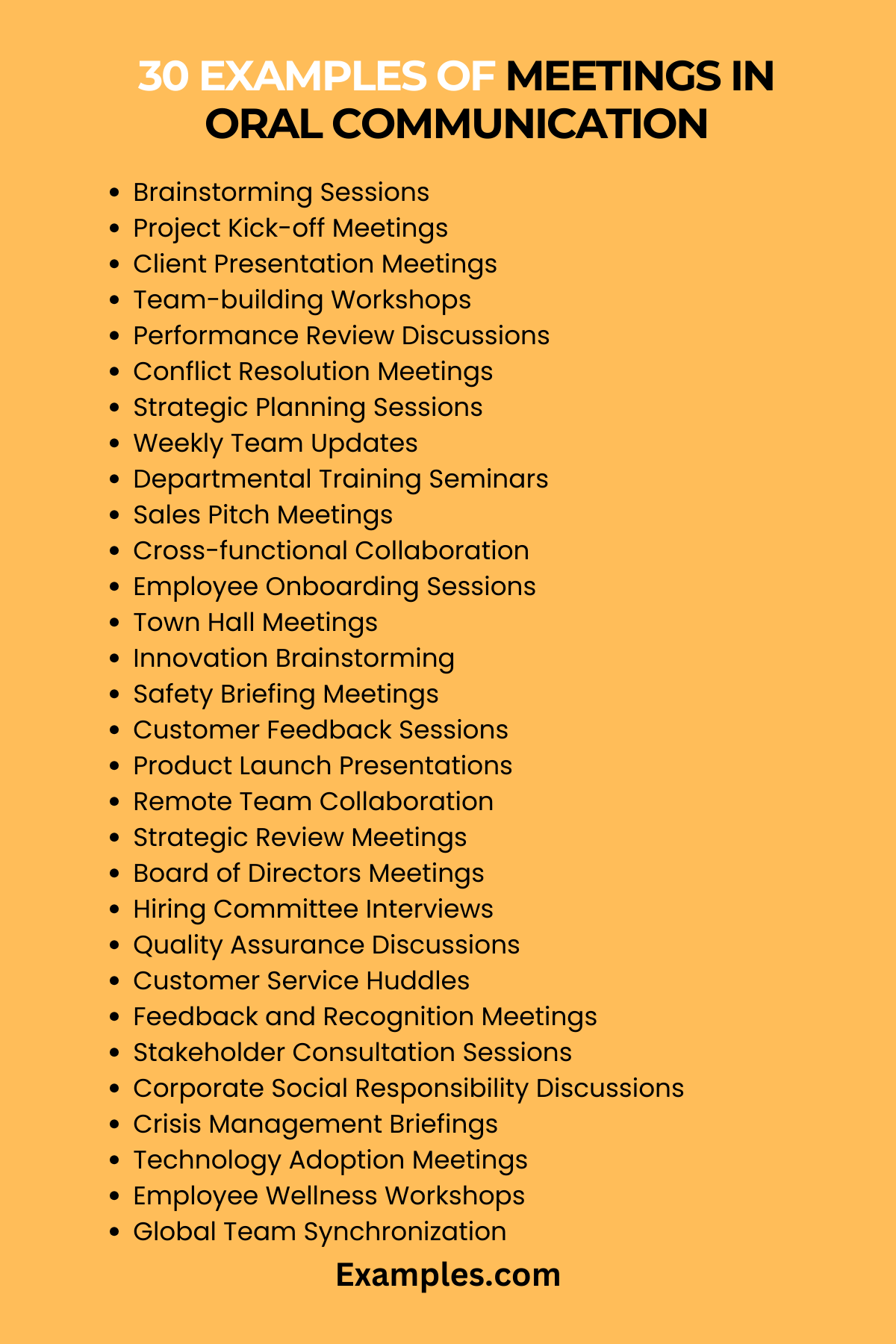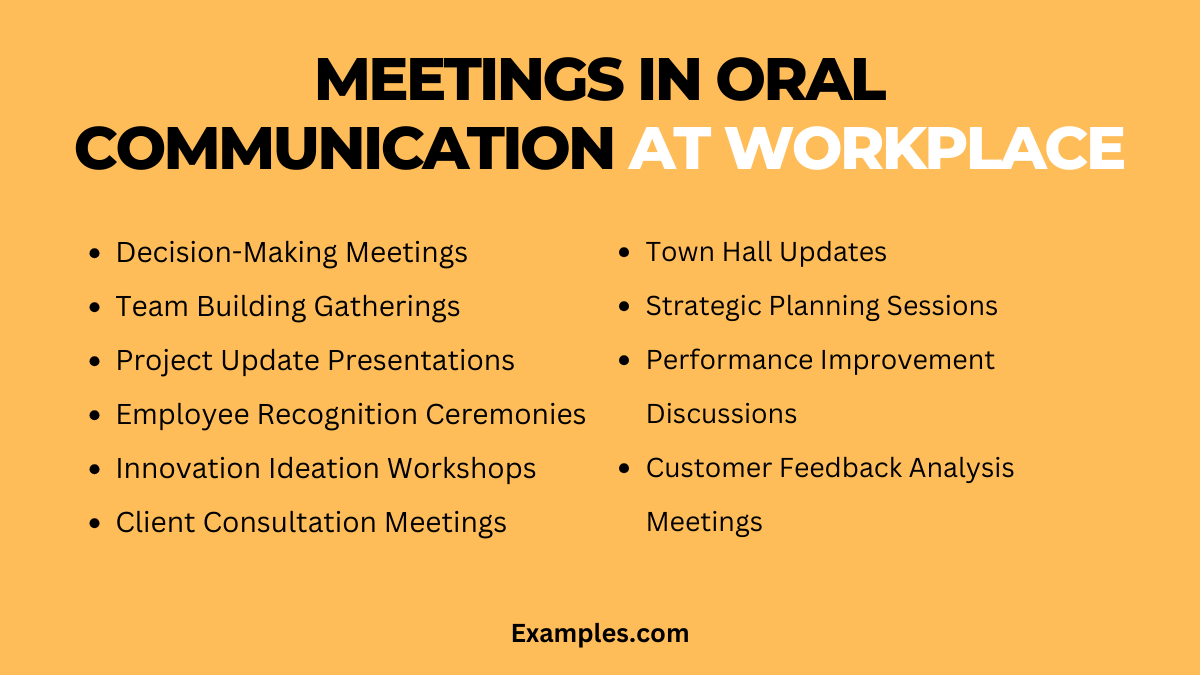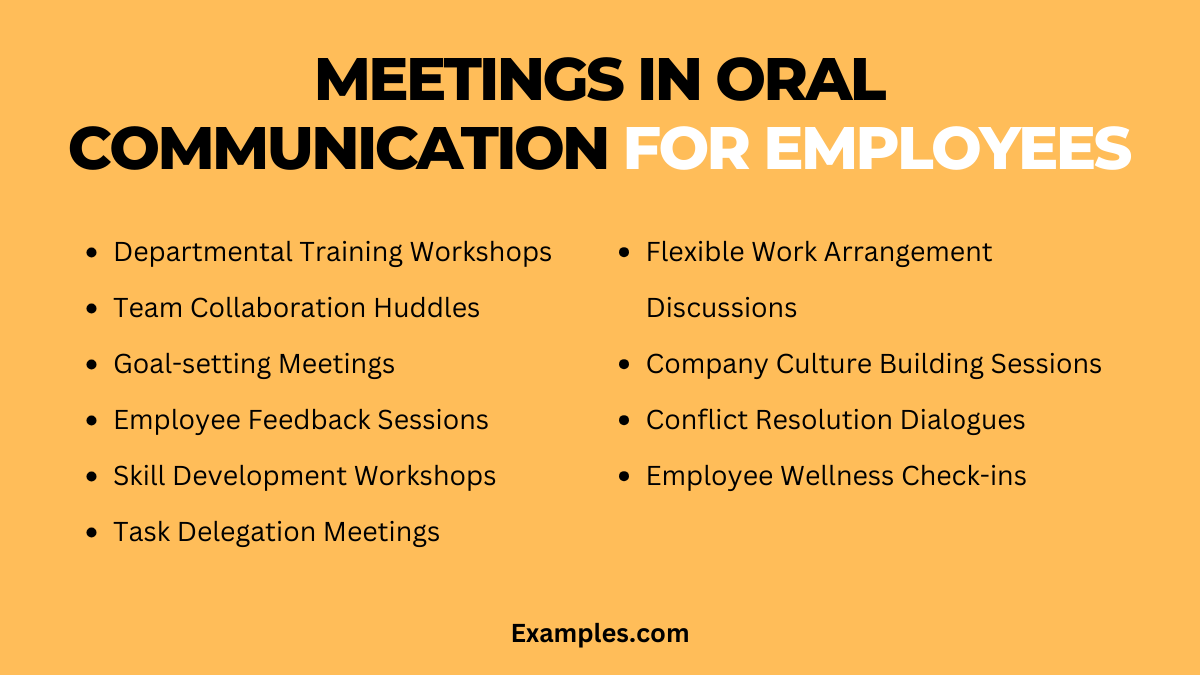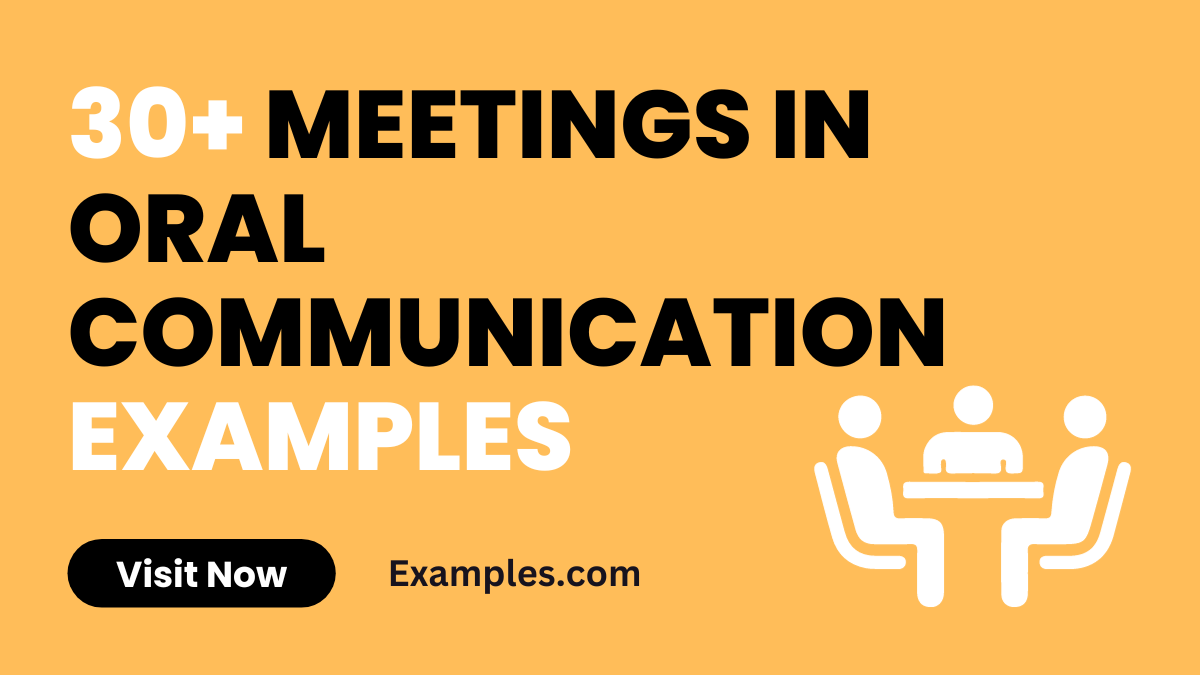Meetings in Oral Communication
Unveil the dynamics of effective workplace communication with our comprehensive guide on Meetings in Oral Communication. Explore diverse examples and gain insights into optimizing meeting strategies. This guide delves into the intricacies of conducting successful meetings, offering practical tips and Communication Examples to enhance collaboration, streamline discussions, and foster a communicative workplace environment. Elevate your meeting skills and ensure your oral communication makes a lasting impact.
30 Examples of Meetings In Oral Communication
Discover 30 dynamic Meetings in Oral Communication Examples, showcasing effective workplace interactions. Explore scenarios, enhance your communication skills, and transform ordinary meetings into impactful sessions.

- Brainstorming Sessions: Boldly initiate idea-sharing discussions. In brainstorming, use assertive communication to ensure every voice is heard.
- Project Kick-off Meetings: Lead project kick-offs with clarity. Employ visual aids for effective communication. Boldly set project objectives for a successful start.
- Client Presentation Meetings: Engage clients confidently. Use persuasive communication to convey value. Boldly showcase solutions and address client queries.
- Team-building Workshops: Facilitate team-building with interactive communication. In workshops, use nonverbal cues to foster team spirit. Boldly encourage open dialogue.
- Performance Review Discussions: Conduct performance reviews with empathy. Use therapeutic communication to address strengths and areas for improvement. Boldly set constructive goals.
- Conflict Resolution Meetings: Handle conflicts diplomatically. In resolution meetings, use assertive communication to address concerns. Boldly guide discussions toward resolution.
- Strategic Planning Sessions: Lead strategic planning with effective communication. Use visual aids to convey objectives. Boldly initiate discussions on long-term goals.
- Weekly Team Updates: Provide weekly team updates with clarity. Use nonverbal cues for emphasis. Boldly communicate achievements and challenges.
- Departmental Training Seminars: Facilitate departmental training with engaging communication. In seminars, use visual aids for clarity. Boldly encourage participation and questions.
- Sales Pitch Meetings: Deliver compelling sales pitches. Use persuasive communication to highlight product benefits. Boldly handle objections and close deals confidently.
- Cross-functional Collaboration: Initiate cross-functional collaboration discussions. Use assertive communication to align teams. Boldly propose ideas for synergy.
- Employee Onboarding Sessions: Conduct onboarding with clear communication. Use visual aids to ease understanding. Boldly foster a welcoming environment for new employees.
- Town Hall Meetings: Lead town hall discussions with transparency. Use assertive communication to address concerns. Boldly engage employees in discussions about company updates.
- Innovation Brainstorming: Encourage innovation discussions. In brainstorming, use visual aids for inspiration. Boldly promote a culture of creative thinking.
- Safety Briefing Meetings: Conduct safety briefings with clarity. Use assertive communication to emphasize protocols. Boldly ensure everyone understands safety measures.
- Customer Feedback Sessions: Gather customer feedback with empathy. In feedback sessions, use therapeutic communication to address concerns. Boldly implement customer suggestions.
- Product Launch Presentations: Present product launches with enthusiasm. Use visual aids to showcase features. Boldly engage the audience with interactive communication.
- Remote Team Collaboration: Facilitate remote collaboration effectively. In virtual meetings, use assertive communication to ensure remote members are heard. Boldly foster a sense of inclusion.
- Strategic Review Meetings: Conduct strategic reviews with clarity. Use visual aids for comprehensive understanding. Boldly guide discussions toward actionable strategies.
- Board of Directors Meetings: Lead board meetings with professionalism. In directorial discussions, use assertive communication to convey insights. Boldly contribute to governance decisions.
- Hiring Committee Interviews: Participate in hiring committees with effective communication. In interviews, use nonverbal cues to gauge candidates. Boldly assess qualifications and cultural fit.
- Quality Assurance Discussions: Conduct quality assurance discussions with precision. In QA meetings, use visual aids for clarity. Boldly address quality issues and improvements.
- Customer Service Huddles: Facilitate customer service huddles with clarity. Use assertive communication to address challenges. Boldly share success stories and best practices.
- Feedback and Recognition Meetings: Conduct feedback and recognition sessions with empathy. Use therapeutic communication to highlight achievements. Boldly celebrate team accomplishments.
- Stakeholder Consultation Sessions: Engage stakeholders in consultative discussions. Use assertive communication to align goals. Boldly seek input and incorporate stakeholder perspectives.
- Corporate Social Responsibility Discussions: Lead CSR discussions with passion. In CSR meetings, use visual aids to showcase initiatives. Boldly inspire commitment to social responsibility.
- Crisis Management Briefings: Handle crises with effective communication. In crisis briefings, use assertive communication to convey action plans. Boldly guide discussions toward resolution.
- Technology Adoption Meetings: Introduce new technologies with clear communication. In adoption meetings, use visual aids for understanding. Boldly address concerns and highlight benefits.
- Employee Wellness Workshops: Facilitate wellness discussions with empathy. Use therapeutic communication to address well-being. Boldly encourage a healthy work-life balance.
- Global Team Synchronization: Coordinate global teams with effective communication. In synchronization meetings, use assertive communication for clarity. Boldly bridge cultural gaps and encourage collaboration.
Meetings in Oral Communication at Workplace
Explore the intricacies of workplace communication with Meetings in Oral Communication. This SEO-friendly guide delves into optimizing meetings for enhanced collaboration and productivity. Elevate your communication skills within the workplace setting, fostering a communicative environment that drives success.

- Decision-Making Meetings: Boldly facilitate decision-making sessions. Use assertive communication to guide discussions and reach consensus on crucial matters.
- Team Building Gatherings: Engage in team-building meetings with enthusiasm. Use nonverbal cues to foster a positive team spirit. Boldly encourage open communication to strengthen team bonds.
- Project Update Presentations: Conduct project update presentations with clarity. Use visual aids for effective communication. Boldly ensure the team is well-informed and aligned with project goals.
- Employee Recognition Ceremonies: Lead employee recognition ceremonies with empathy. Use therapeutic communication to acknowledge achievements. Boldly celebrate individual and team successes.
- Innovation Ideation Workshops: Facilitate innovation ideation workshops. Use assertive communication to inspire creative thinking. Boldly guide discussions toward actionable and innovative ideas.
- Client Consultation Meetings: Engage in client consultation meetings with professionalism. Use visual aids to explain proposals. Boldly address client concerns and tailor solutions to their needs.
- Town Hall Updates: Lead town hall updates with transparency. Use assertive communication to share company updates. Boldly encourage employee participation in discussions about organizational direction.
- Strategic Planning Sessions: Coordinate strategic planning sessions with precision. Use nonverbal cues for emphasis. Boldly guide discussions toward defining and achieving long-term organizational objectives.
- Performance Improvement Discussions: Conduct performance improvement discussions with empathy. Use therapeutic communication to address challenges. Boldly collaborate on setting goals for professional growth.
- Customer Feedback Analysis Meetings: Analyse customer feedback in meetings. Use assertive communication to identify areas for improvement. Boldly implement strategies based on customer insights for enhanced satisfaction.
Meetings in Oral Communication for Employees
Empower employees through effective communication in Meetings in Oral Communication for Employees. This guide emphasizes optimizing meetings to boost engagement, morale, and collaboration among team members.

- Departmental Training Workshops: Conduct departmental training workshops with clarity. Use visual aids for comprehensive understanding. Boldly equip employees with essential skills and knowledge.
- Team Collaboration Huddles: Facilitate team collaboration huddles. Use assertive communication to align team goals. Boldly encourage open dialogue and idea-sharing for improved teamwork.
- Goal-setting Meetings: Lead goal-setting meetings with enthusiasm. Use nonverbal cues to convey commitment. Boldly guide discussions toward setting individual and team objectives.
- Employee Feedback Sessions: Conduct employee feedback sessions with empathy. Use therapeutic communication to address concerns. Boldly create an environment where feedback is valued for continuous improvement.
- Skill Development Workshops: Facilitate skill development workshops. Use assertive communication to inspire learning. Boldly encourage employees to actively participate in refining their skills.
- Task Delegation Meetings: Delegate tasks effectively in meetings. Use visual aids for clarity. Boldly communicate expectations and ensure each team member’s role is well-defined.
- Flexible Work Arrangement Discussions: Engage in discussions about flexible work arrangements. Use assertive communication to address concerns. Boldly promote a flexible and inclusive work environment.
- Company Culture Building Sessions: Lead company culture building sessions with transparency. Use nonverbal cues to embody the desired culture. Boldly encourage employees to contribute to shaping the organizational culture.
- Conflict Resolution Dialogues: Handle conflicts through open dialogues. Use therapeutic communication to foster understanding. Boldly guide discussions toward resolution, promoting a harmonious workplace.
- Employee Wellness Check-ins: Conduct employee wellness check-ins. Use assertive communication to demonstrate care. Boldly address well-being and offer resources to support employees’ health.
Is a Meeting a Form of Communication?
Meetings play a pivotal role in organizational communication, serving as dynamic forums for the exchange of ideas, information, and decisions. In this comprehensive guide, we explore the intricate relationship between meetings and oral communication. Delve into the fundamental aspects, nuances, and the significance of meetings as a distinct form of communication. From understanding the dynamics of verbal and nonverbal cues to dissecting the various purposes meetings serve, this guide navigates the landscape where effective oral communication converges with collaborative gatherings. Explore insights, practical tips, and the transformative power of meetings within the broader spectrum of organizational communication.
What are the three purposes of a meeting in oral communication?
In the realm of oral communication, meetings serve as pivotal platforms for collaboration, ideation, and decision-making. This comprehensive guide explores the three fundamental purposes that make meetings integral to effective communication strategies.
1. Facilitating Collaboration and Information Exchange: Meetings provide a dynamic space for teams to collaborate, share information, and exchange ideas. Discover how fostering open communication channels during meetings enhances teamwork, sparks creativity, and ensures that every team member is aligned with organizational goals.
2. Decision-Making and Problem-Solving Dynamics: Delve into the role of meetings as decision-making arenas where critical choices are deliberated and solutions are crafted. Explore strategies for guiding discussions, reaching consensus, and leveraging oral communication to make informed decisions that drive organizational success.
3. Enhancing Communication and Team Alignment: Uncover the significance of meetings in fostering a cohesive team environment. Learn how effective oral communication in meetings strengthens team bonds, aligns members with shared objectives, and creates a platform for transparent and inclusive communication.
In conclusion to the article on “Meetings in Oral Communication,” it is evident that the way we communicate in meetings significantly impacts their effectiveness and the outcomes achieved. Assertive communication plays a crucial role in this regard, enabling participants to express themselves effectively, respect others’ viewpoints, and contribute to constructive and productive discussions.
Assertive Communication in Meetings
Being assertive is a core communication skill that is particularly important in meetings. Assertiveness helps in clearly articulating your ideas and standing up for your point of view while respecting others. This balance ensures that meetings are not only productive but also inclusive, allowing all voices to be heard and considered. For more insights into the value of assertiveness in communication, particularly in stressful scenarios like meetings, the Mayo Clinic offers a comprehensive guide on Being Assertive: Reduce Stress, Communicate Better??????.
Enhancing Meeting Effectiveness
Additionally, understanding and implementing effective meeting strategies can transform the dynamics of workplace communication. Strategies such as setting clear agendas, encouraging participation, and following up on action items can significantly improve meeting outcomes. For a deeper exploration into running effective meetings, McKinsey provides valuable insights in their article on How to Run Effective Meetings??. These strategies, coupled with assertive communication, create an environment where meetings are not only efficient but also empowering for all participants.
Incorporating these approaches into meeting practices can enhance collaboration, streamline discussions, and foster a communicative workplace environment, ultimately leading to more successful and impactful meetings.



